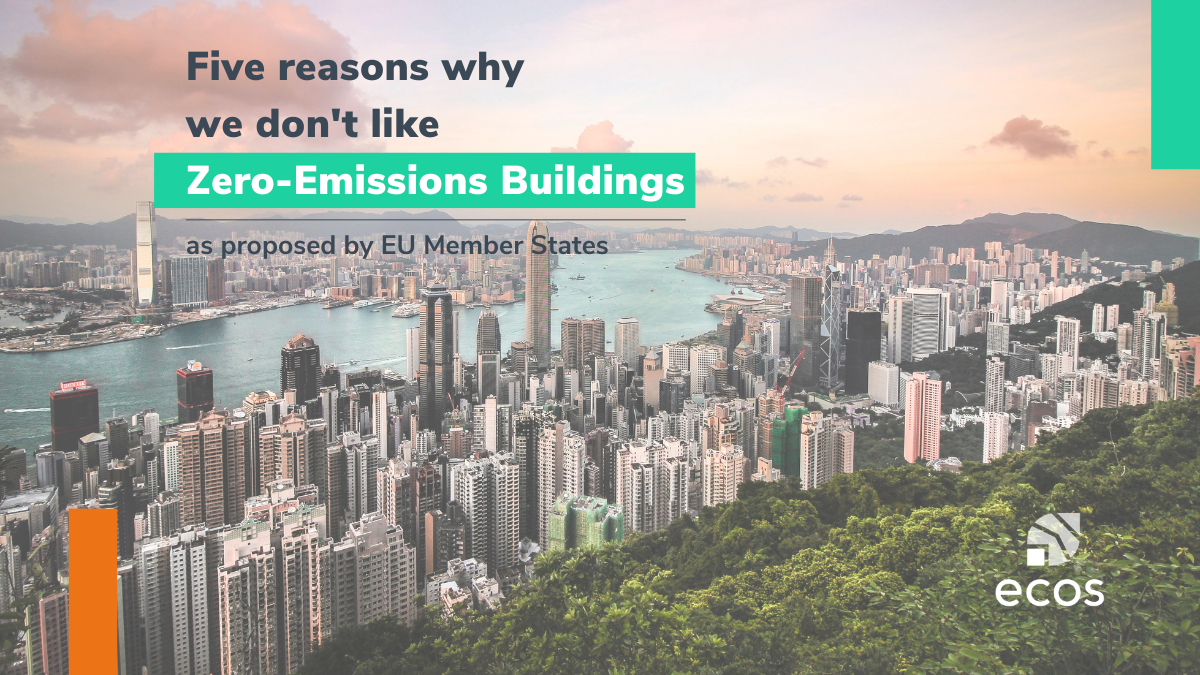Five reasons why we don’t like Zero-Emissions Buildings – as proposed by EU Member States
As part of the fit-for-55 package, the Energy Performance of Buildings Directive (EPBD) is being revised to boost renovations and improve the sustainability of homes, offices, and all other types of buildings.

Buildings are responsible for approximately 36% of all EU emissions, making EPBD requirements essential to reduce and decarbonise EU energy demand and meet EU 2050 climate targets.
In late October, in response to the Commission’s Recast proposal, national energy ministers agreed on a position that will not deliver on the aim of a zero-emissions, climate-neutral building stock by 2050. So, it is now up to the European Parliament to re-establish the climate credibility of the EPBD and EU building decarbonisation policies.
Appropriately defining what a zero-emissions building looks like is essential, then. To make a long story short, Zero-Emissions Buildings (ZEB) criteria will be applied to all new buildings from 2030 and as a target for the entire building stock to achieve by 2050. Based on this rightfully long-term policy approach, ZEB criteria must be future-proof. However, last political discussions among Member States have resulted in a Council proposal that puts forward a range of unsustainable energy and emissions criteria. Unfortunately, this decision provides a basis for a building stock that will not be compatible with climate neutrality by 2050.
Luckily, national ministers do not have the last word in this case. Members of the European Parliament can still help rectify the short-sightedness of national energy ministers: MEPs can enshrine truly Paris-aligned, 2050-compatible criteria for true Zero-Emissions Buildings (ZEB). Doing so is essential for the EPBD to avoid the ‘zero-emission-washing’ of unsustainable buildings.
What is so wrong with the newly proposed EPBD ZEB criteria?
Here are our five reasons why we don’t like Zero-Emissions Buildings (and must avoid including them in the revised EPBD):

- ZEBs do have emissions.
Yes, that’s right: Zero-Emissions Buildings of the future may not be emission-free. In fact, they are likely to produce emissions during use: only not where the building is located, but somewhere far away where the energy is produced – potentially where the gas is used to generate heat, where the material resources are burned, or where the forest is cut down for biomass or biogas fuel. Furthermore, the use of the so-called ‘low-carbon’ energy sources is not defined and risks substantial overshoot of EU climate targets.
- ZEBs will lock us in the use of emitting energy carriers.
Continuing to permit the use of unsustainable energy sources will continue to channel investments towards gas infrastructure rather than in establishing non-emitting, renewable energy systems. Faced with the energy and climate crises, we should focus on the latter. This dangerous distraction risks reducing and delaying public and private investments in a clean energy transition by 2050. Europe cannot afford to delay this any longer.
- ZEBs will only be introduced from 2030 onwards.
With the proposed criteria to be introduced only as of 2030, each new building built until then could be a missed opportunity to reduce carbon and instead may constitute a step towards continued fossil-fuel reliance. Improved criteria need to enter into force in the next five years to send a direct signal to the market to immediately integrate ZEB criteria into construction projects being planned for completion before the end of the decade.
- ZEBs are not future-proof.
The definition of ZEBs will remain unchanged from 2030 to 2050, meaning two decades of building and (deep) renovation resulting in unsustainable buildings. The initial proposal recognises that a transition should have already occurred by 2030 by requiring ZEBs with low energy consumption to be supplied only as renewables. The EPBD proposed by the Council is far away from this with no guarantee of ambitious energy-use limits or the use of only clean, renewable energy. ZEBs will immediately be outdated and incompatible with carbon neutrality by 2050.
- Embodied emissions are completely ignored.
The definition of Zero Emission Buildings only covers the use of the building and not the emissions embodied in the materials used to construct and renovate it – missing up to 50% of all emissions from the construction of an energy-efficient building. Consequently, some high-preforming ZEBs of the future could have no operational emissions while using materials from highly polluting industries. Therefore, climate neutrality based on ZEB criteria must consider embodied emissions.
Buildings are the single largest energy consumer in Europe. Therefore, more than ever, it is time to realise our ambitions starting from 2030.
The solution is clear: fix the Zero-Emissions Building criteria by defining ZEBs to align with EU and global climate targets for 2050, as intended. This alignment means enshrining ZEB definition as buildings supplied by only renewable energy that is free of emissions (on-site and off-site) in line with the central aim of the EPBD Recast proposal of a zero-emissions, climate-neutral building stock by 2050.
The ZEB definition has long-term implications, so it is now or never for Zero-Emission Buildings to lead the way.

 By
By  By
By 
